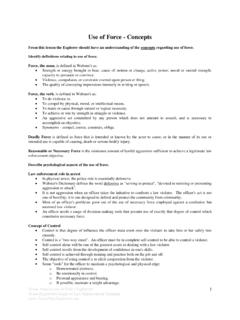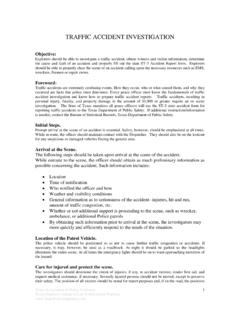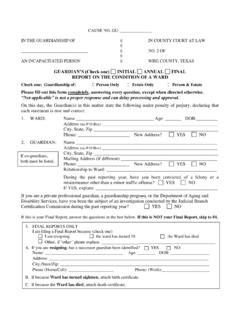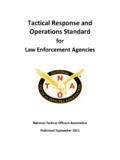Transcription of Building Clearing / Tactical Raid - Wise County, Texas
1 Building Clearing / Tactical Raid Objective: Explorers should learn the difference between a deliberate and dynamic Building Clearing . Explorers should be able to employ techniques for a regular patrol response to a Building Clearing situation and a Tactical raid search typically used in narcotic raids. Explorers should be able to use Tactical thinking during these scenarios and demonstrate the ability for a team to work together in Clearing a Building . Foreword: Tactical thinking is an active process where the officer must consider all the options and tactics available, when faced with a potentially dangerous situation. The bottom line is that the officer must pay attention to details. You must understand that you are the most important individual out there. Take responsibility before force is escalated. Tactical thinking is doing the very things that you have been trained to do - safely and efficiently. Can this happen? The answer is yes, but it takes effort on your part.
2 Tactical Thinking: While most police actions are suspect-based, Tactical thinking is officer- based. Suspect-based actions occur when we become too overwhelmed with the quick capture of the offender and forget about everything else going on around us. In this situation, things can get out of control quickly. This results in cross-fires, improper handcuffing techniques, and total convergence on the offender by all officers. It leaves no one to provide cover. Ideally, an officer should not focus solely on the suspect. The officer should focus on his/her own actions, rather than what the suspect is doing. By maintaining this focus, you become more effective in controlling your own emotions. You make stronger Tactical decisions and only escalate the force, if necessary. This internal focus protects you and allows you to make sound decisions. This is the officer-based approach to solving any difficult situation. Mental and physical attitude and actions affect how the threat interprets the team's aggressiveness.
3 A. mindset of complete domination must be maintained throughout any Building Clearing operation. Tactical fundamentals of Building Clearing are: Mental Preparedness. 1. Be mentally prepared for the physical changes your body will experience as a result of the flight or fight response during these operations: 2. Increased blood pressure, heart rate, and blood flow to major muscle groups. 3. Decreased blood flow to extremities, making simple movements, and dexterity almost impossible. 4. Visual difficulties in tracking, ability to focus deteriorates; the peripheral field narrows. 5. Visualize success performing tasks under various challenging conditions. Control fear, it is normal, and everyone experiences it: Do not let it overpower you. Channel it into anger or aggression. Remain in control, and you will be fine. Have confidence in yourself. Fight as you have trained. Hence the importance of "Train as you fight." Train to a conditioned response. Texas Association of Police Explorers 1.
4 Texas Explorer's Guide to Law Enforcement Training Move Without Detection. The importance of this fundamental speaks for itself. Tactically and silently. Be in the correct order. Avoid unnecessary movement (foot shuffling, fidgeting, etc). Call a minimal amount of equipment to reduce noise and fatigue. Secure loose items (Jump check). Assume proper positions (stay off walls, keep your balance, etc). Control the Distance. An important fundamental of BC is controlling the distance to the threat. Avoid distances closer than six feet for a standing threat and four feet for a threat on the ground. At a distance: Increased reaction time. Increased options in use of force, finding cover, and verbal persuasion. More team members and weapons on threat. Up close: Less reaction time. Fewer options. Weapon retention concerns. May block target acquisition of other team members. Create distance by: Use of weapon capabilities (eyes on target and or precision shooting).
5 Use thermal or other night vision imagery. Use lighting. Use less lethal options. Dominate the Area. An area is dominated when a minimum of two members of the entry team move points that allow total control of the area with proper interlocking fields of fire. Occupation of these points with interlocking fields of fire serve to overwhelm the threat (create a dilemma) and provide different angles of fire to cover potential dead space. Be aware of your position and surroundings. Scan to break tunnel vision. Eliminate the Threat. Eliminating the threat may be accomplished with lesser means of force than deadly force. When deadly force is used, the team must effectively eliminate the threat as quickly as possible with accurate and discriminating fire. This can be accomplished from or while moving to their dominating positions. As stated in Army FM 23-35, Combat Pistol, "the battle is not won with the first shot! It is won with the first accurate shot.". Control the Situation and Personnel.
6 It is essential that in the initial few moments of a Clearing operation the team maintain total control of the situation and all personnel in the room. Lost control is not easily regained. The dilemma, disorientation, confusion, and sometimes panic created in the mind of the threat must be fully exploited as a measure of control. Team members must communicate clearly and always ready to take charge. Texas Association of Police Explorers 2. Texas Explorer's Guide to Law Enforcement Training Search the Area. A quick but complete search of the room is critical in determining if any potential threat to the team exists. Search anything that may conceal a threat (behind doors, furniture, etc). The room search is conducted by a minimum of a two-man team. One covers and the other searches. Great consideration should be given when searching the room if the possibility of booby traps exists. What is the benefit or need? What are the likely results? Search the Living, Injured, and Dead.
7 The living, injured, and dead must be searched to ensure that they no longer pose a threat. The search is conducted by a minimum of a three-man team in large areas that contain a threat but are not cleared: One man searches the threat. One man covers the threat. One man covers the room. Remove any weapons on or near the body. Cautiously check for signs of life on motionless and unresponsive threats. Provide medical attention if necessary. Evacuate Personnel and Equipment. If personnel or equipment recovery was the purpose of the Clearing operation, these assets should be evacuated immediately. Account for all organic personnel and equipment. Refer to team SOP and or rules of engagement for evacuation procedures of the threat(s), wounded, and dead. Entry Planning Considerations Determine number of necessary personnel for mission. Mandated by METT-T. A. minimum of five personnel are necessary to conduct Building Clearing . Three (3) personnel per threat should be committed to any mission when multiple threats are expected.
8 Three (3) to four (4) team members per room is ideal. The team must be prepared to deny the threat any chance of escape or effective retaliation. The following details must be considered when determining the number of entry team members for the mission: Number of threats, non combatants, or bystanders and their equipment capabilities. Size, complexity, number, type of structures, areas, and exterior danger areas. Entry point number and type. Control and apprehension of the threat. Texas Association of Police Explorers 3. Texas Explorer's Guide to Law Enforcement Training What equipment is necessary in order to effect a successful entry and Clearing operation. What environment is the team likely to encounter? What is the anticipated reaction by the threat? Approach the Entry Point Time and distance from the last covered and concealed position (LCC) to entry must be as short as possible. Move with 360-degree security with cover from Marksman/Observers. Team must be in proper order for necessary actions at the entry point.
9 Have primary and alternate entry point selected prior to departing CP and have a contingency plan for compromise. Attempt a deliberate approach when possible. Actions at the Entry Point Make a quick check of the entry point. Plan to breach two entry points. When entering at ground level with a small Clearing team, it is preferable to enter at the end of the Building rather from the middle. This will limit possible threats to the front. Entering the Building in the middle will cause the small team to split-up. When entering at ground level with a large Clearing team, a middle assault working outward can offer the fastest and safest method of Clearing . Actions Outside the Entry Point Select a position based on the characteristics of the entry point. Team members must train to immediately recognize the characteristics of various entry points and setup to provide maximum security and the smoothest entry possible. Position on the side that provides the least path of resistance.
10 Maximize coverage whenever possible by positioning team members left and right of the opening. Team members lining up on the hinge side will have first view and easiest access. Inward opening doors: Team Members position themselves on the opposite side of the door knob. Outward opening doors: Team members position themselves on the door knob side. Prevents team members from having to deal with the door. Easy access to typical locks and doorknobs. Minimizes obstacles. Maximizing speed. Texas Association of Police Explorers 4. Texas Explorer's Guide to Law Enforcement Training Individual Position. 1. Keep in mind that a threat may come from any angle. 2. Each member must be prepared to meet and defeat it. 3. A simple thing such as foot position or muzzle may give away your location to the threat. 4. The body must be positioned correctly to avoid compromise and facilitate surprise, speed, and aggressive action. Head and Eyes: aligned with threat and or area of responsibility.







